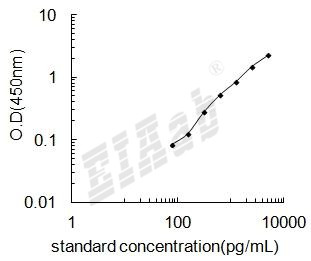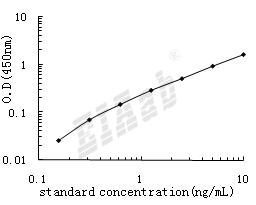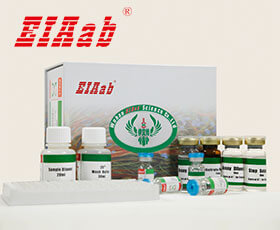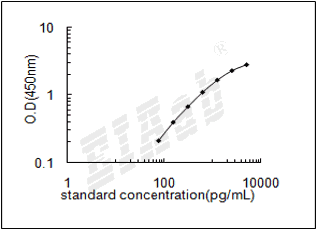Prkaa2 (基因名), 5'-AMP-activated protein kinase catalytic subunit alpha-2 (蛋白名), AAPK2_MOUSE.
产品名称:
Mouse Prkaa2/ 5'-AMP-activated protein kinase catalytic subunit alpha-2 ELISA Kit
5′-腺苷酸活化蛋白激酶催化亚单位α-2
货号:
E10189m
商标:
EIAab®
监管等级:
别名:
Acetyl-CoA carboxylase kinase, Hydroxymethylglutaryl-CoA reductase kinase, ACACA kinase, HMGCR kinase, AMPK subunit alpha-2
检测方法:
ELISA
实验类型:
Sandwich
检测范围:
78-5000pg/mL
灵敏度:
39.6pg/mL
特异性:
Natural and recombinant mouse 5'-AMP-activated protein kinase catalytic subunit alpha-2
样品类型:
Serum, plasma, tissue homogenates, cell culture supernates and other biological fluids
样品数据:
登录.
实验步骤:

研究领域:
Cardiovascular
精密度
批内差:已知浓度的3个样本在一个板子内重复检测20次,以评估批内精密度。
批内 CV: ≤8.2%
批间差:已知浓度的3个样本在不同的板子上重复测定5次,以评估测定批间精密度。
批间 CV: ≤9.7%
批内 CV: ≤8.2%
批间差:已知浓度的3个样本在不同的板子上重复测定5次,以评估测定批间精密度。
批间 CV: ≤9.7%
回收率
回收率:低、中和高浓度的分析物被掺入到血清或者血浆样本中,进行回收实验测定。
|
Sample Type |
Average(%) |
Recovery Range(%) |
|
Serum |
109 |
103-115 |
|
Plasma |
111 |
105-117 |
线性
线性:给定样本通过梯度稀释,每次稀释的测量值与理论值的比值。
|
Sample |
1:2 |
1:4 |
1:8 |
1:16 |
|
serum(n=5) |
108-117% |
94-103% |
117-127% |
91-101% |
|
EDTA plasma(n=5) |
97-106% |
88-98% |
90-102% |
110-120% |
|
heparin plasma(n=5) |
100-109%
|
108-120% |
91-101% |
105-115% |
通用注释
亚单元:
AMPK is a heterotrimer of an alpha catalytic subunit (PRKAA1 or PRKAA2), a beta (PRKAB1 or PRKAB2) and a gamma non-catalytic subunits (PRKAG1, PRKAG2 or PRKAG3). Interacts with FNIP1 and FNIP2.
功能:
Catalytic subunit of AMP-activated protein kinase (AMPK), an energy sensor protein kinase that plays a key role in regulating cellular energy metabolism. In response to reduction of intracellular ATP levels, AMPK activates energy-producing pathways and inhibits energy-consuming processes: inhibits protein, carbohydrate and lipid biosynthesis, as well as cell growth and proliferation. AMPK acts via direct phosphorylation of metabolic enzymes, and by longer-term effects via phosphorylation of transcription regulators. Also acts as a regulator of cellular polarity by remodeling the actin cytoskeleton; probably by indirectly activating myosin. Regulates lipid synthesis by phosphorylating and inactivating lipid metabolic enzymes such as ACACA, ACACB, GYS1, HMGCR and LIPE; regulates fatty acid and cholesterol synthesis by phosphorylating acetyl-CoA carboxylase (ACACA and ACACB) and hormone-sensitive lipase (LIPE) enzymes, respectively. Regulates insulin-signaling and glycolysis by phosphorylating IRS1, PFKFB2 and PFKFB3. Involved in insulin receptor/INSR internalization (By similarity). AMPK stimulates glucose uptake in muscle by increasing the translocation of the glucose transporter SLC2A4/GLUT4 to the plasma membrane, possibly by mediating phosphorylation of TBC1D4/AS160. Regulates transcription and chromatin structure by phosphorylating transcription regulators involved in energy metabolism such as CRTC2/TORC2, FOXO3, histone H2B, HDAC5, MEF2C, MLXIPL/ChREBP, EP300, HNF4A, p53/TP53, SREBF1, SREBF2 and PPARGC1A. Acts as a key regulator of glucose homeostasis in liver by phosphorylating CRTC2/TORC2, leading to CRTC2/TORC2 sequestration in the cytoplasm. In response to stress, phosphorylates 'Ser-36' of histone H2B (H2BS36ph), leading to promote transcription. Acts as a key regulator of cell growth and proliferation by phosphorylating TSC2, RPTOR and ATG1/ULK1: in response to nutrient limitation, negatively regulates the mTORC1 complex by phosphorylating RPTOR component of the mTORC1 complex and by phosphorylating and activating TSC2. In response to nutrient limitation, promotes autophagy by phosphorylating and activating ATG1/ULK1. AMPK also acts as a regulator of circadian rhythm by mediating phosphorylation of CRY1, leading to destabilize it. May regulate the Wnt signaling pathway by phosphorylating CTNNB1, leading to stabilize it. Also phosphorylates CFTR, EEF2K, KLC1, NOS3 and SLC12A1. Plays an important role in the differential regulation of pro-autophagy (composed of PIK3C3, BECN1, PIK3R4 and UVRAG or ATG14) and non-autophagy (composed of PIK3C3, BECN1 and PIK3R4) complexes, in response to glucose starvation. Can inhibit the non-autophagy complex by phosphorylating PIK3C3 and can activate the pro-autophagy complex by phosphorylating BECN1 (PubMed:23332761).
亚细胞位置:
Cytoplasm
Nucleus
In response to stress, recruited by p53/TP53 to specific promoters.
数据库链接
UniGene:
SMR:
STRING:
KEGG:
Pfam:
Uniprot:
该产品尚未在任何出版物中被引用。
[1].
小鼠5′-腺苷酸活化蛋白激酶催化亚单位α-2(Prkaa2)ELISA试剂盒可以做多少个样本?
小鼠5′-腺苷酸活化蛋白激酶催化亚单位α-2(Prkaa2)ELISA试剂盒分为2种规格,96孔和48孔。96孔的试剂盒,标曲和样本都做复孔的话,可以检测40个样本。96孔的试剂盒,标曲和样本都不做复孔的话,可以检测88个样本。
[2].
小鼠5′-腺苷酸活化蛋白激酶催化亚单位α-2(Prkaa2)ELISA试剂盒使用视频?
小鼠5′-腺苷酸活化蛋白激酶催化亚单位α-2(Prkaa2)ELISA试剂盒实验操作视频在以下网址中,对每一步的实验步骤都做了演示,方便实验员能更好地理解ELISA实验的过程。
https://www.eiaab.com.cn/lesson-tech/805.html
https://www.eiaab.com.cn/lesson-tech/805.html
[3].
小鼠5′-腺苷酸活化蛋白激酶催化亚单位α-2(Prkaa2)ELISA试剂盒是放在-20℃冰箱保存吗?
EIAab的小鼠5′-腺苷酸活化蛋白激酶催化亚单位α-2(Prkaa2)ELISA试剂盒,洗涤液、底物、终止液保存于4℃,其余试剂-20℃冰箱保存。
[4].
小鼠5′-腺苷酸活化蛋白激酶催化亚单位α-2(Prkaa2)ELISA试剂盒原理?
双抗体夹心法:用纯化的抗体包被微孔板,制成固相抗体,往包被有固相抗体的微孔中依次加入标准品或受检样本、生物素化抗体、HRP标记的亲和素,经过彻底洗涤后用底物TMB显色。用酶标仪在450nm波长下测定吸光度(OD值),计算样本浓度。
竞争法:用纯化的抗体包被微孔板,制成固相抗体,往包被有固相抗体的微孔中依次加入标准品或受检样本和生物素标记的目标分析物,受检标本中抗原与生物素标记抗原竞争结合有限的抗体。再加入HRP标记的亲和素,经过彻底洗涤后用底物TMB显色。用酶标仪在450nm波长下测定吸光度(OD值),计算样本浓度。
竞争法:用纯化的抗体包被微孔板,制成固相抗体,往包被有固相抗体的微孔中依次加入标准品或受检样本和生物素标记的目标分析物,受检标本中抗原与生物素标记抗原竞争结合有限的抗体。再加入HRP标记的亲和素,经过彻底洗涤后用底物TMB显色。用酶标仪在450nm波长下测定吸光度(OD值),计算样本浓度。
[5].
小鼠5′-腺苷酸活化蛋白激酶催化亚单位α-2(Prkaa2)ELISA试剂盒中需要使用的样品量是多少?
夹心法100μL/孔,竞争法50μL/孔。如样本浓度过高时,应对样本进行稀释,以使稀释后的样本符合试剂盒的检测范围,计算时再乘以相应的稀释倍数。
[6].
如何分析小鼠5′-腺苷酸活化蛋白激酶催化亚单位α-2(Prkaa2)ELISA试剂盒数据?
建议标准曲线,并计算样本浓度。对于elisa的曲线拟合,一般建议采用4参数曲线拟合,4参数曲线拟合通常更适合免疫分析。推荐使用专业软件进行曲线拟合,例如curve expert 1.3。根据样本的OD值由标曲查出相应的浓度,再乘以稀释倍数;或用标准物的浓度与OD值计算出标曲的回归方程式,将样本的OD值代入方程式,计算出样本浓度,再乘以稀释倍数,即为样本的实际浓度。以下链接是curve expert 1.3软件拟合曲线的方法。
https://www.eiaab.com.cn/news/502/
https://www.eiaab.com.cn/news/502/
[7].
小鼠5′-腺苷酸活化蛋白激酶催化亚单位α-2(Prkaa2)ELISA试剂盒中是否包含人和动物的副产物,是否包含感染的或者传染性原料如HIV等?
除了抗体和稀释液中的BSA,不含其它人和动物的副产物,也不含感染材料。
[8].
收集小鼠5′-腺苷酸活化蛋白激酶催化亚单位α-2(Prkaa2)ELISA试剂盒血浆样本,用什么作为抗凝剂?
一般建议用EDTA和肝素作为抗凝剂。
[9].
小鼠5′-腺苷酸活化蛋白激酶催化亚单位α-2(Prkaa2)ELISA试剂盒酶标板可以拆成几部分?拆的时候是否需要避光,无菌?
小鼠5′-腺苷酸活化蛋白激酶催化亚单位α-2(Prkaa2)ELISA试剂盒酶标板是8×12孔条,可拆卸,板子可以拆成12条,注意避免孔污染,不需要避光和无菌。暂时不用的板子,放回原来装的袋子里,密封保存。
[10].
小鼠5′-腺苷酸活化蛋白激酶催化亚单位α-2(Prkaa2)ELISA试剂盒样本如何保存?
尽量检测新鲜样本。若无新鲜样本,则4℃保存1周,-20℃保存1个月,-80℃保存2个月。
反馈墙
评论数 : 0
所有用户
所有用户
默认排序
默认排序
最近
早期
目前还没有评论。






通知
规格
数量
单价 (¥)
小计 1 (¥)
小计 2:
¥

规格
数量
单价 (¥)








 验证序列:
验证序列:




 折扣:
折扣: